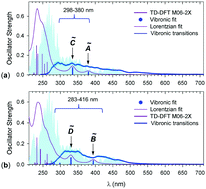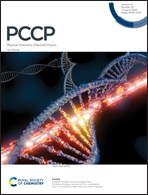Guanine–adenine interactions in DNA tetranucleotide cation radicals revealed by UV/vis photodissociation action spectroscopy and theory†
Abstract
Hydrogen-rich cation radicals (GATT + 2H)+˙ and (AGTT + 2H)+˙ represent oligonucleotide models of charged hydrogen atom adducts to DNA. These tetranucleotide cation radicals were generated in the gas phase by one-electron reduction of the respective (GATT + 2H)2+ and (AGTT + 2H)2+ dications in which the charging protons were placed on the guanine and adenine nucleobases. We used wavelength-dependent UV/Vis photodissociation in the valence-electron excitation region of 210–700 nm to produce action spectra of (GATT + 2H)+˙ and (AGTT + 2H)+˙ that showed radical-associated absorption bands in the near-UV (330 nm) and visible (400–440 nm) regions. Born–Oppenheimer molecular dynamics and density-functional theory calculations were used to obtain and rank by energy multiple (GATT + 2H) dication and cation-radical structures. Time-dependent density functional theory (TD-DFT) calculations of excited-state energies and electronic transitions in (GATT + 2H)+˙ were augmented by vibronic spectra calculations at 310 K for selected low-energy cation radicals to provide a match with the action spectrum. The stable product of one-electron reduction was identified as having a 7,8-dihydroguanine cation radical moiety, formed by intramolecular hydrogen atom migration from adenine N-1–H. The hydrogen migration was calculated to have a transition state with a low activation energy, Ea = 96.5 kJ mol−1, and positive activation entropy, ΔS‡ = 75 J mol−1 K−1. This allowed for a fast isomerization of the primary reduction products on the ion-trap time scale of 150 ms that was substantially accelerated by highly exothermic electron transfer.



 Please wait while we load your content...
Please wait while we load your content...